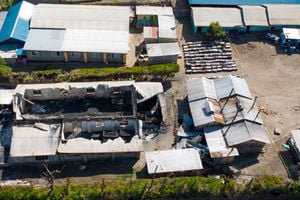Asthmatics in trouble as inhalers run out of stock

While childhood asthma shares similarities with asthma in adults, it presents unique challenges for children, including emergency department visits, hospitalisations, and missed school days.
Barely a week ago, Wanjiru Njuguna walked into a chemist, prescription in hand, to restock her child’s Ventolin inhalers. This is a type of medication that relaxes muscles in the airways and increases air flow into the lungs. It is used to treat or prevent narrowing of the airways in the lungs in people with asthma.
Before that, Wanjiru had bought the inhalers in bulk, enough to last about six months. At the chemist, she was told the specific brand she was seeking has been out of stock for months and was offered an alternative.
“This other brand goes for about Sh1,700, yet we would get Ventolin for between Sh350 and Sh400,” says Wanjiru.
“Salbutamol, the generic option, has also been out of stock. When you are not using Ventolin, you use Salbutamol,” she explains.
Mary*, who is asthmatic, says that the inhalers went out of stock just after the new government took office.
“Ventolin used to be something that a normal person could afford. Now it goes for around Sh1,500. God forbid that you are allergic to Ventolin; you will have to buy the alternative, such as Budecort, which used to be sold for about Sh450 but now goes for at least Sh2,800,” she explains.
Read: Managing asthma
She adds that sometimes, when an asthmatic person’s chest gets congested, the patient will need to be nebulised. To do this, one uses a nebuliser, a machine that creates a mist out of liquid medication, allowing for quicker and easier absorption into the lungs.
“As we speak, you cannot nebulise in a government clinic because they don’t have the drugs. If they do, they will give you Salbutamol. If you are allergic to the drug, you will have to go a private hospital, where you will likely spend at least Sh2, 000 for the nebulisation. If you don’t have the money, you are doomed,” she explains.
According to Healthine, an asthma attack occurs when a person’s airways become narrower than normal, causing difficulty in breathing, with severity ranging from mild to very serious.
Symptoms include severe shortness of breath, tightness or pain in the chest, coughing or wheezing and a fast heart rate. It describes use of a rescue inhaler as the “preferred way of treating an asthma attack”. The rescue inhaler contains medication that expands the airways.
The World Health Organisation (WHO) says asthma is the most common chronic disease among children. Childhood asthma involves heightened inflammation of the lungs and airways, triggered by exposure to substances like pollen, contracting a cold, or other respiratory infections.
While childhood asthma shares similarities with asthma in adults, it presents unique challenges for children, including emergency department visits, hospitalisations, and missed school days.
Kenyans may have to wait until 2026 for new eco-friendly Ventolin inhalers. In November last year, GlaxoSmithKline (GSK), the manufacturer of the Ventolin inhalers, officially announced that it was transitioning to join drug makers like AstraZeneca and Novo Nordisk in the quest to reduce its carbon emissions. This, they said, is because using a Ventolin inhaler produces the same carbon dioxide as driving for 300 kilometres, hence contributing to climate change.
“It accounts for close to half (49 per cent) of GSK’s carbon footprint, as well as contributing to the carbon footprint of global health systems. Significantly reducing the carbon footprint of the propellant in the inhaler is a key milestone in the company’s pathway to net zero,”GSK said on November 23.
To stop this, GSK announced it would start the third phase of trials of a low carbon version of the inhaler, using a next generation propellant, this year. If successful, the firm said, the new product would “reduce greenhouse gas emissions from use of the inhaler by approximately 90 per cent, significantly contributing to GSK’s ambitious net-zero climate targets.” Regulatory submissions would then begin in 2025.
The shortage of Ventolin inhalers in the country is also due to a shortage of liquid albuterol that hit the US last year, when the manufacturer of generic albuterol, Akorn Pharmaceuticals, filed for bankruptcy and reportedly closed its US facilities.
Following the shortage, most asthma patients turned to albuterol inhalers, creating further shortage, and pushing them to Ventolin inhalers that are now out of stock in many countries around the world.
In late October 2023, the US Food and Drug Administration (FDA) put asthma medication albuterol on its drugs shortage list, with experts noting that the situation would get worse.






